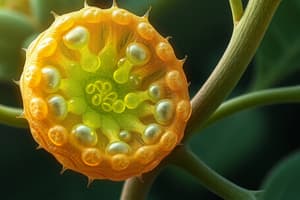Podcast
Questions and Answers
Which cell type is primarily responsible for photosynthesis, storage, and secretion in plants?
Which cell type is primarily responsible for photosynthesis, storage, and secretion in plants?
- Sclerenchyma cells
- Parenchyma cells (correct)
- Collenchyma cells
- Fiber cells
What is the primary function of collenchyma cells in plants?
What is the primary function of collenchyma cells in plants?
- Photosynthesis
- Water conduction
- Protection against herbivores
- Providing support in soft, non-woody organs (correct)
Which cell types are part of the xylem tissue in plants?
Which cell types are part of the xylem tissue in plants?
- Sieve tube elements and companion cells
- Sclereids and cork cells
- Parenchyma and guard cells
- Tracheids and vessel elements (correct)
Which type of sclerenchyma cell is commonly found in the shells of nuts?
Which type of sclerenchyma cell is commonly found in the shells of nuts?
What role do sieve plates play in the phloem tissue?
What role do sieve plates play in the phloem tissue?
What is the main function of the epidermis in plant tissues?
What is the main function of the epidermis in plant tissues?
Which of the following statements about parenchyma cells is true?
Which of the following statements about parenchyma cells is true?
What type of cells primarily compose the phloem tissue in plants?
What type of cells primarily compose the phloem tissue in plants?
Flashcards
What is plant tissue?
What is plant tissue?
A group of cells that work together to perform a specific function in a plant.
What is the ground tissue system?
What is the ground tissue system?
The ground tissue system is responsible for carrying out essential functions like photosynthesis, storage, and support in plants.
Describe the characteristics of parenchyma cells.
Describe the characteristics of parenchyma cells.
Parenchyma cells are the workhorses of the plant, carrying out essential functions such as photosynthesis, storage, and secretion.
What is the function of collenchyma cells?
What is the function of collenchyma cells?
Signup and view all the flashcards
How do sclerenchyma cells differ from parenchyma and collenchyma cells?
How do sclerenchyma cells differ from parenchyma and collenchyma cells?
Signup and view all the flashcards
What is the vascular tissue system?
What is the vascular tissue system?
Signup and view all the flashcards
What is the function of xylem?
What is the function of xylem?
Signup and view all the flashcards
What is the function of phloem?
What is the function of phloem?
Signup and view all the flashcards
Study Notes
Plant Cells and Tissues
- Plant tissues are groups of cells that work together for structure and function.
- Tissues form systems in plants.
- There are three tissue systems: ground, vascular, and dermal.
Ground Tissue System
- Parenchyma cells:
- Unspecialized plant cells.
- Thin walls.
- May contain chlorophyll.
- Loosely packed.
- Functions: photosynthesis, storage, secretion.
- Collenchyma cells:
- Living plant cells.
- Unevenly thickened primary walls.
- Provide support in soft, non-woody plant parts.
- Sclerenchyma cells:
- Plant cells with extremely thick walls, providing strength and support to the plant body.
- Two types:
- Sclereids: found in shells of nuts, stones of fruits, pears.
- Fibers: found in wood, inner bark, and leaf ribs.
Vascular Tissue System
- Xylem:
- Transports water and dissolved minerals throughout the plant.
- Tracheids and vessel elements conduct water and minerals.
- Parenchyma cells are for storage.
- Fibers provide support.
- Phloem:
- Transports food (sugars) throughout the plant body.
- Sieve tube elements are long, thin cells stacked end-to-end forming sieve tubes.
- Sieve plates are end walls with holes for cytoplasm to connect cells.
- Companion cells are adjacent to sieve tube elements; assist in functions of sieve tube elements.
Dermal Tissue System
- Epidermis:
- Outermost layer (usually one cell thick).
- Covers the plant body.
- Cuticle is secreted on stems and leaves to reduce water loss.
- Stomata facilitate carbon dioxide diffusion during photosynthesis.
Meristems
- Apical meristems:
- Located at tips of stems and roots.
- Produce primary tissues (responsible for plant's primary growth — increasing length).
- Lateral meristems:
- Located on the side of the vascular plant.
- Vascular cambium and cork cambium give rise to secondary tissues (responsible for secondary growth, widening the plant).
Periderm
- Outermost layer of cells.
- Covers woody stems and roots.
- Consists of cork cells (dead at maturity).
- Coated with suberin (a waxy substance).
- Cork parenchyma (phelloderm) is for storage.
Studying That Suits You
Use AI to generate personalized quizzes and flashcards to suit your learning preferences.




